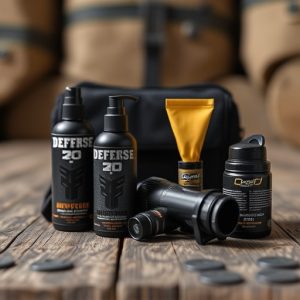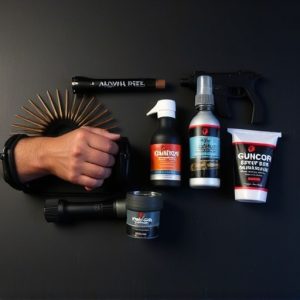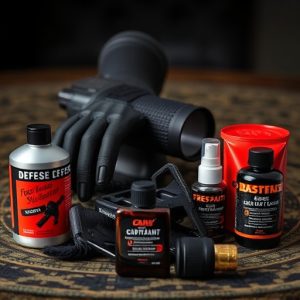Navigating Personal Defense Products: Evolution, Selection, and Usage in Self-Defense Strategies
Personal defense products have transformed individual safety strategies from reliance on traditiona…….
Personal defense products have transformed individual safety strategies from reliance on traditional weaponry to encompass a range of non-lethal options that emphasize prevention and de-escalation. These products are specifically designed for effectiveness across various threat scenarios, including pepper sprays that temporarily incapacitate attackers and stun guns delivering high-voltage electric shocks that do not cause lasting harm. The strategic use of these tools is key to effectively neutralizing aggressors while minimizing the risk of serious injury or fatality. Integrating personal defense products into one's safety plan is a proactive step for those prioritizing preparedness and situational awareness, ensuring legal and ethical self-defense practices in harmony with contemporary societal standards and legal considerations. The evolution of these products reflects a historical shift from lethal to less lethal weapons, driven by technological advancements and changing societal needs. From primitive tools like slingshots and spears to modern devices like pepper sprays and electronic control devices (ECDs), the progression showcases a commitment to safety and effectiveness in personal defense. When selecting a product, it's essential to consider its legality, ease of use, portability, reliability under stress, and user-friendliness. Proper training is indispensable for effective and lawful use, ensuring that users are well-informed about both the technical aspects and legal implications of their chosen personal defense product. A combination of hands-on proficiency and informed legal awareness is crucial for confident and responsible deployment of these products in self-defense situations.
When it comes to safeguarding one’s well-being in unpredictable circumstances, personal defense products have become integral tools for modern self-defense. This article delves into the multifaceted role these products play within contemporary self-defense strategies, examining their evolution from historical artifacts to sophisticated deterrents. We will explore the key considerations necessary for selecting effective personal defense tools, ranging from pepper spray and stun guns to impact tools, providing a comprehensive overview of each type. Additionally, we will address the importance of training with these products and the legal frameworks governing their use. Understanding the nuances of personal defense products empowers individuals to make informed decisions for their safety.
Understanding the Role of Personal Defense Products in Modern Self-Defense Strategies
The landscape of personal defense has evolved significantly with the advent of specialized personal defense products. These innovative tools are designed to provide individuals with effective deterrents against potential threats, aligning with modern self-defense strategies that emphasize prevention over confrontation. Personal defense products now incorporate a range of non-lethal solutions tailored to various scenarios, from pepper sprays that incapacitate attackers with irritant compounds to stun guns offering high-voltage electric shocks without causing permanent harm. The strategic deployment of these devices can neutralize an aggressor while minimizing the risk of serious injury or fatality.
Incorporating personal defense products into one’s self-defense plan is a prudent step for individuals seeking to enhance their safety. These items are not merely substitutes for traditional weaponry; they represent a thoughtful approach to protection, emphasizing the importance of preparedness and situational awareness. The effectiveness of these products lies in their accessibility and non-lethal nature, which allows users to defend themselves legally and ethically. As self-defense laws become more nuanced, understanding the role of personal defense products within this context is crucial for anyone interested in safeguarding their well-being in a manner that aligns with modern societal norms and legal frameworks.
The Evolution of Less Lethal Weapons: A Look at Historical and Contemporary Examples
Throughout history, the development of weapons has been a reflection of technological advancements and changing societal needs. The concept of less lethal weapons has evolved significantly from ancient deterrents to modern personal defense products. Historically, tools such as slingshots, spears, and clubs were employed for self-defense and to incapacitate opponents without causing permanent harm or death. These rudimentary devices were the precursors to the sophisticated non-lethal weapons available today.
The 20th century marked a pivotal point in the evolution of less lethal weaponry with the advent of chemical irritants and projectile devices designed for crowd control and personal defense. Pepper sprays, stun grenades, and batons emerged as tools for law enforcement to manage public order and protect individuals without resorting to deadly force. The rapid advancement in technology has further refined these products, leading to a wide array of personal defense products now readily available to the public. From pepper spray keychains to electronic control devices (ECDs), these modern tools offer a range of options for effective self-defense while minimizing the potential for serious injury. These contemporary personal defense products continue to be improved upon, ensuring they meet both legal standards and the immediate needs of personal safety.
Key Considerations When Selecting Personal Defense Products for Effective Self-Protection
When considering personal defense products for effective self-protection, it’s crucial to evaluate the balance between capability and usability. These tools are intended to deter aggressors or incapacitate them if necessary, ensuring your safety. Key among these considerations is the legality of the product in your jurisdiction, as well as its compliance with relevant laws and regulations. Portability and ease of access during an encounter are also vital; devices should be conveniently carried without drawing unwanted attention.
Additionally, personal defense products must be reliable under pressure. This means they should operate effectively when adrenaline might impair fine motor skills. Familiarity with the product through practice is essential to ensure proficiency in its use. Safety features that prevent accidental discharge or misuse are also important, as they minimize the risk of injury or legal complications. Furthermore, the potential for collateral damage must be considered; select products that aim to subdue rather than harm indiscriminately. By carefully analyzing these factors and choosing products tailored to your personal needs and local laws, you can make an informed decision that enhances your self-protection strategy.
Types of Personal Defense Products: Pepper Spray, Stun Guns, and Impact Tools
Personal defense products serve as a critical deterrent against physical threats, offering individuals a non-lethal means to protect themselves. Among the diverse range of personal defense tools available, pepper spray, stun guns, and impact tools are prominent choices for self-defense due to their efficacy and legal status. Pepper spray, also known as OC (oleoresin capsicum) spray, is a highly effective non-lethal tool that can incapacitate an attacker by causing intense irritation to the eyes and respiratory system upon contact. It provides a temporary yet significant defense mechanism that allows users to escape and seek help. Stun guns, or electroshock weapons, deliver a high-voltage, low-ampere electrical shock, effectively neutralizing an assailant by overwhelming their muscular-neural functions. These devices are designed with user safety in mind, often featuring non-lethal currents that comply with legal standards for personal defense. Impact tools, such as batons and kubotans, utilize force to create discomfort or incapacitate an aggressor. The design of these tools concentrates the impact over a small area, which can be more effective than open-hand techniques and are typically within legal limits for self-defense. Each of these personal defense products plays a crucial role in non-lethal self-protection strategies, offering varying levels of protection tailored to specific self-defense scenarios. Users should familiarize themselves with the operation, legal use, and proper handling of these devices to effectively employ them when faced with a threat.
Training and Legal Implications Associated with the Use of Personal Defense Products
When considering the adoption and use of personal defense products, comprehensive training is paramount to ensure their effective deployment in self-defense scenarios. Training programs must be rigorous, providing users with a deep understanding of the product’s capabilities, limitations, and legal implications. These programs should cover proper handling, aiming, and usage under various conditions, as well as the potential consequences of misuse. Understanding the legal framework surrounding personal defense products is equally critical, as laws vary by jurisdiction. Users must be aware of the regulations governing the use of force in self-defense, which can differ significantly from one location to another. This knowledge is essential for avoiding legal repercussions that could arise if a product is used improperly or outside the bounds of the law. Furthermore, manufacturers and retailers have a responsibility to provide clear instructions and safety guidelines with each product. By equipping consumers with both the practical skills and the legal know-how, the use of personal defense products can be both effective and compliant with applicable laws. This dual focus on training and legal education serves to mitigate risks and ensures that individuals are well-prepared should they need to use these products in a self-defense situation.


